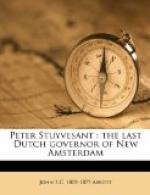“You have committed a great folly. Had it been my case, I would have helped the Englishman to some eight pound iron beans, and have prevented him from going up the river. The English are of so haughty a nature that they think that everything belongs to them. I would immediately send a frigate after him, and drive him out of the river.”
Stimulated by this advice, Van Twiller prepared, as speedily as possible, three well armed vessels, strongly manned with soldiers, and sent them, under an intrepid captain, in pursuit of the intruders. They found the English ship, the William, about a mile below fort Orange. A tent was pitched upon the shore, where, for a fortnight, the English had been pursuing a very lucrative traffic for furs. The Dutch soldiers were in strength which Elkins could not resist.
They ordered him to strike his tent. He refused. They did it for him; reshipped all his goods which he had transferred to the shore, to trade with the Indians, and also the furs which he had purchased. They then weighed the anchors of the William, unfurled her sails, and, with trumpet blasts of victory, brought the ship, captain and crew down to fort Amsterdam. The ship was then convoyed to sea, and the discomfited Elkins returned to London. Thus terminated, in utter failure, the first attempt of the English to enter into trade with the Indians of New Netherland.
The Dutch were now the only Europeans who had occupied any part of the present territory of New York, New Jersey, Pennsylvania and Delaware. They were also carrying on a very flourishing trade with the Indians on the Connecticut river, which was then called Fresh river, and this “long before any English had dreamed of going there.” The Value of this traffic may be inferred from the fact that, in the year 1633, sixteen thousand beaver skins were sent to Holland from the North river alone.
To strengthen their title, thus far founded on discovery and exclusive visitation, the Dutch, in 1632, purchased of the Indians nearly all of the lands on both sides of the Connecticut river, including Saybrook Point, at the mouth, where the arms of the States-General were affixed to a tree in token of possession. A fort was also commenced, near the mouth of the river, and a trading post established some miles up the stream, at the point now occupied by the city of Hartford.
About the same time, Lord Warwick, assuming that a legitimate grant of the region had been made to him by the king of England, conveyed to Lords Say, Brook and others, all the territory running southwest from Narragansett river, to the distance of one hundred and twenty miles along the coast, and reaching back, through the whole breadth of the country, from the Western Ocean to the South Sea. The geography of these regions was then very imperfectly known. No one had any conception of the vast distance between the Atlantic Ocean and the shores of the Pacific. The trading post, which the Dutch had established on the Connecticut, was called Fort Hope.




